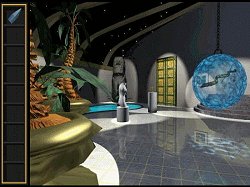|
Beyond Time
 Beyond Time is based on the novel, Obelisk, written by Dr. Judith Kaye Jones and begins as a crisis looms in the realms of antiquities and art. Alas, despite the use of the most advanced security systems, priceless treasures are being mysteriously plundered from monuments and museums all around the world. Michelangelo's Pieta has vanished without trace, so has the entire Tutankhamen collection, and you have been summoned to investigate the matter.
Your task is to travel to the Temple of Osiris, in Abydos, on the West Bank of the Nile, where there are rumours of strange occurrences. There is an archaeological dig in progress at this ancient site and not only have workers fled in fear but, quite miraculously, a golden artefact that vanished from the Cairo Museum has turned up half-buried in the sand. Beyond Time is based on the novel, Obelisk, written by Dr. Judith Kaye Jones and begins as a crisis looms in the realms of antiquities and art. Alas, despite the use of the most advanced security systems, priceless treasures are being mysteriously plundered from monuments and museums all around the world. Michelangelo's Pieta has vanished without trace, so has the entire Tutankhamen collection, and you have been summoned to investigate the matter.
Your task is to travel to the Temple of Osiris, in Abydos, on the West Bank of the Nile, where there are rumours of strange occurrences. There is an archaeological dig in progress at this ancient site and not only have workers fled in fear but, quite miraculously, a golden artefact that vanished from the Cairo Museum has turned up half-buried in the sand.
Play starts as you arrive at the deserted Osiris dig and a quick reconnaissance confirms that there is some truth to the rumours. As you approach the great Statue of Osiris it is bathed in an eerie light and you are pulled into another time.
Your job now is to search the temple ruins and during the process you'll meet up with some ancient temple-dwellers who are also trapped in time. After they relate their tale of woe it will soon become apparent that you are not the only time traveller visiting ancient Egypt as there is also another archaeological expedition, from another future-time, taking a great deal of interest in ancient works of art. The opposition (so to speak) have set up a timegate to retrieve their plunder, but their expedition has run into serious trouble tinkering with time, hence your dilemma. In order to escape you must ultimately come to the rescue of time itself ... past, present and future.
It's a complex story involving an interesting paradox of time, perhaps a little too complex to port to a computer game of this nature in which it was always going to be difficult to expand the plot to fully appreciate the paradox it so tantalisingly proposes. Even the game is something of a paradox as, despite the complexity of the story it is for the most part neither difficult nor complex, but it still manages to be fairly cohesive.
I say this because, regardless of its shortcomings, it nevertheless presents the player with an intriguing gameworld and a clear pathway through the game, weaving in a number of interesting puzzles that are generally not too harrowing. Really, it is because of its simplicity, that Beyond Time is so playable.
Many of the puzzles in Beyond Time are of the type that require careful reading of books and scrolls to extract the relevant information. No huge leaps of logic are necessary in this respect, just careful observation and note taking. For instance, they might contain the answer to a riddle or a pictorial code to open a door. There are also a number of items such as keys to collect, but they are few and never too far out of reach. Really, only two puzzles have any complexity and these are pure logic-type problems ... one of them posed serious problems for me.
The interface, too, is simplicity itself. To indicate movement the cursor changes into various pointers, and to pick up or zoom in on objects/puzzles it appears as an open hand. A click of the right mouse-button displays a small menu bar allowing access to features such as saving and loading, inventory, help files, etc.
The major part of this game is set in ancient Egypt, but via the use of the timegate you will also visit Lhasa in Tibet, The Mayan City of Tikal and also Atlantis. The graphics are detailed and colourful (if not state-of-the-art) and present an interesting world to explore. Overall it is quite good to play, but it really is too short and it doesn't reach the same heights as similar games involving time-travel such as Timelapse. By all means take a look, but don't expect too much.
Copyright © Rosemary Young 1998.
All rights reserved.
System requirements:
IBM Compatible 486/66 or above (minimum), 8MB Installed RAM (16 MB strongly recommended), Apple(tm) QuickTime(r) for Windows(tm) 2.1.2 (included), 640x480 Super VGA with 256 color resolution minimum (16-, 24- or 32- bit strongly recommended), Windows compatible sound card, 7MB available hard disk space (10MB if QuickTime is not already installed), Windows 3.1 or later.
|
